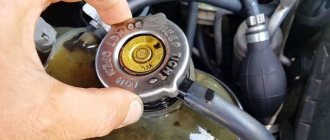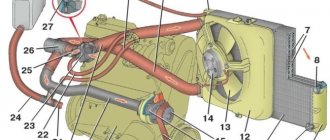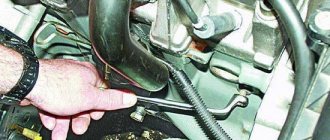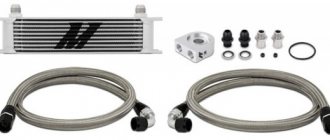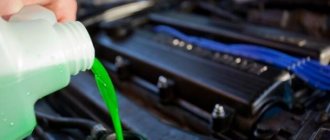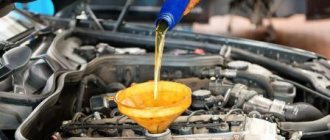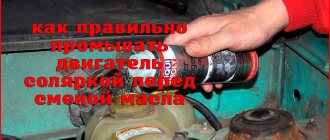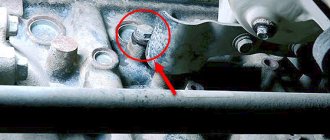Antifreeze or antifreeze getting into the oil is one of the reasons for immediately flushing the oil system. Despite the fact that motor oil contains a whole package of protective, detergent and dispersant components, they may not be enough to restore properties.
New oil will not solve the problem either, since it will not be able to properly clean the surfaces of parts and engine channels from various deposits, sediment, etc.
As a result of mixing with coolant, the oil turns into an emulsion, which can harm the power unit. Let's talk about how to avoid this by diagnosing the problem in time and eliminating it by flushing.
Flushing the engine oil system: when needed
So, antifreeze or antifreeze can get into the lubrication system for various reasons, but the most common culprit is damage to the cylinder head gasket. Less commonly, cracks form in the block or head. In any case, the result of mixing oil and coolant is an emulsion.
This phenomenon is very dangerous for the engine, since the lubricant loses its properties, and the wear of the cylinder head, crankshaft, timing gear and other elements and components in the internal combustion engine increases significantly. Moreover, water and ethylene glycol, mixed in certain proportions and, in fact, representing coolant, after entering the oil, cause coagulation of various contaminants.
Simply put, dirt in the lubrication system literally sticks together. Additives in oil and antifreeze react after mixing and quickly decompose, the oil immediately oxidizes, etc. Large “lumps” consisting of deposits can even clog the oil receiver mesh filter, resulting in
engine oil starvation
.
It is important to take into account that, for example, after replacing the cylinder head gasket, it will not be possible to completely drain the waste from the engine. This means that if you fill in a new portion of fresh lubricant, the lubricant will also mix with the remaining emulsion, and unwanted deposits will still form in the oil channels and on the internal surfaces of the engine.
If the engine is not additionally flushed, this situation will repeat for at least 2-3 more replacements. We also note that similar recommendations also apply when, for some reason, the oil change interval was violated (for example, the lubricant was replaced not after 10 thousand km, but after 15 thousand). Flushing is also recommended if it is necessary to add oil from a third-party manufacturer, when it was necessary to mix mineral oil and synthetics, etc.
At the same time, flushing the engine may be necessary if the owner purchased a used car, and the service history of a particular car is unknown or questioned. It often happens that after changing the oil on such a machine, the fresh lubricant turns black very quickly (literally after 50-100 km).
Finally, it is also worth highlighting the possible filling of low-grade oil into the engine. Among motor oils, unfortunately,
fakes are common
. Naturally, after discovering this fact, you need to remove the surrogate from the internal combustion engine, then the engine must be flushed.
A counterfeit product is usually indicated by strong and rapid blackening of the lubricant, an unpleasant pungent odor, the appearance of black deposits under the valve covers, cloudiness of the oil, a significant change in its viscosity for no obvious reason, increased lubricant consumption, engine smoking, etc.
Video
Emulsion under the valve cover
Do not be alarmed if you find an emulsion under the oil filler cap, but the oil on the dipstick is in normal condition. The accumulation of plaque, whose consistency and color resembles condensed milk, occurs due to moisture condensation. The autumn-winter period and frequent trips over short distances are the most favorable conditions for the accumulation of condensation.
In the crankcase ventilation system, air mixed with combustion products of the air-fuel mixture and oil vapor has a certain percentage of humidity. The heated mixture inevitably condenses on cooled surfaces. But when the engine and all its parts warm up, the moisture gradually evaporates. With frequent cold starts and short runs, some elements do not have time to warm up to the temperature required for evaporation. As a result, the emulsion accumulates under the oil filler cap.
Is it possible to overcome the problem?
The emulsion itself under the engine cover is not dangerous. It is enough to wipe it occasionally with a clean cloth. If the car is the second in the family and is used only in the city, try to periodically go on the highway with it. Long periods of operation within the operating temperature range will prevent emulsion accumulation.
On gasoline internal combustion engines, frequent cold starts and short distances are also dangerous due to the accumulation of gasoline in the oil. In the start-up and warm-up modes, the ECU enriches the mixture, which causes more gasoline to enter the crankcase through the piston rings. Fuel dilutes the oil and impairs its lubricating properties. Under such conditions, loaded friction pairs wear out intensively: cylinder walls, liners, crankshaft journals, camshafts. When a warm engine runs for a long time, gasoline naturally evaporates from the oil and enters the intake manifold through the crankcase ventilation system.
Pay attention to the crankcase ventilation system
Much more dangerous is the accumulation of condensate in remote oil separators, tees and hoses of the crankcase ventilation system. This situation occurs in severe frost and most often after long periods of idle time. At idle speed, a small amount of exhaust gases breaks into the crankcase, while the vacuum in the intake manifold is close to maximum (the throttle is closed or slightly open at a small angle). In order not to create unnecessary vacuum in the crankcase, the system takes in air through a hose cut into the corrugation up to the throttle valve. When heated gases mix with frosty air in the tee, the accumulating condensate freezes, blocking the passage of crankcase gases. In the best case, after this, the gases push out the dipstick, splashing the engine compartment with oil, in the worst case, they squeeze out the seals.
Description of the problem
A dipstick is used to check the lubricant level in the engine crankcase. When the element is removed from the engine, a cloudy white or yellowish coating mixed with engine oil appears on the surface. A similar emulsion is formed on the inner surface of the plug installed in the hole for filling lubricant into the engine. The car owner needs to understand why the foreign deposit has formed.
How to properly flush the cooling system
Any car engine cooling system (ECS) consists of water pipes (hoses), radiators (main and heating), a thermostat, and a water pump, which ensures forced circulation of coolant. As a result of constant interaction with heated metal, as well as from aging, various deposits accumulate in the liquid (antifreeze or antifreeze), and it begins to become cloudy. Oil from the engine can also get into the antifreeze; it penetrates into the ODS due to a leak in the cylinder head gasket.
There are different methods for flushing cooling channels and radiators, in general they are not fundamentally different from each other, the difference lies only in the use of compositions and the sequence of actions. You can flush the engine cooling system with water without resorting to any chemicals, but this is the case when it is not too dirty and there are no traces of oil in it. Properly flushing the SOD means completely getting rid of dirt or oil (emulsion), while the antifreeze must be transparent and the engine must be at operating temperature (not overheat). And it is very important to choose a composition suitable for washing that will not harm the car, but will only benefit it!
Cleaning the system using special auto chemicals
There are several effective cleaning products on the Russian market that can be used to flush the cooling system of oil residues:
- ABRO AB-505 - removes limescale, rust and oil deposits. Volume 354 ml, poured into a cooling system filled with water. After heating the engine to operating temperature, you need to let it idle for half an hour. Then, turn off the engine. Next, you need to flush the system with the engine running, with the drain valve open, constantly pouring water into the radiator or expansion tank until the drained liquid becomes clear.
- LIQUI MOLYKuhlerreiniger is an effective product containing enzymes and surfactants designed to dissolve and remove scale and contaminants (including grease) from the cooling system and neutralizes acid. The composition does not contain aggressive alkalis and acids, so it can be recommended to use it with each replacement. It is neutral to rubber, metal and plastic. To clean, you need to pour liquid into the system (one jar per 10 liters of antifreeze). Then warm up the engine and let it idle for 10 - 30 minutes. The poured liquid can be left in the system for a period of up to three hours, and during the use of the machine. After draining the old antifreeze, the system must be rinsed with running water and a new one can be added.
- LAVR—set for two-stage, complete rinsing. Specially designed to work with very complex stains and consists of two bottles:
- Rust and scale remover (first stage) - poured into an empty system, and then it is filled with clean, preferably distilled water, to the minimum level. Then you need to warm up the engine and leave it running for half an hour.
- Cleaner of oil-emulsion deposits and various residues of decomposition of old coolant (second stage). After draining the first solution, liquid from the second bottle is poured into the system, and the system is again filled with water to the minimum mark. The car is started, warmed up and left to idle for half an hour. Then the solution is drained, the system is filled again with clean water, the engine is warmed up and left to run for 15 minutes. The last procedure should be repeated until clean water begins to drain from the system and after that the system can be filled with antifreeze.
What is the engine lubrication system?
This system, by reducing the frictional forces of the elements, increases the life expectancy of all components of the device. As an addition, oil removes excess heat that is generated during the operation of components or a specific element. In order to achieve the maximum positive effect from the lubrication system, it is important to fill in the engine oil that will fully correspond to the operating modes of the engine.
The main components that make up the engine lubrication system:
- Filter.
- Oil pump.
- The oil pan contains most of the oil.
- Hoses and supply tubes.
The system is perfectly sealed, so it will be problematic for other liquids to get there. This was achieved by installing many gaskets and seals.
When the engine starts, the oil pump starts working and gradually increases the pressure. Oil flows through the system, having previously passed through a cleaning filter. The fluid primarily lubricates the components where severe wear is possible - the crankshaft journal, camshafts and valves. After which it drains into the crankcase, where it hits the connecting rod and is scattered onto the cylinder walls. Next, the oil scraper rings clean the cylinders. The entire lubrication process is uninterrupted and lasts as long as the motor is running.
Reviews from motorists who have tried the diesel fuel flushing method
Good reviews about the method of washing an engine with diesel fuel are mainly left by owners of outdated equipment. For example, drivers often wash ZMZ and VAZ engines with diesel fuel. Here, in most cases, there are no pronounced negative consequences. Although it is not a fact that in one wash the car owner did not reduce the engine life of thousands by 50 km.
You can also find negative reviews on the Internet. For example, after filling with diesel fuel, the engine seized. After disassembly, worn out and twisted liners were discovered.
Therefore, the conclusion about this method of cleaning the engine is this: you can use diesel fuel, but carefully and only on well-preserved outdated engines.
To keep your car's engine running like a clock, you must adhere to service intervals and contact a car service center in a timely manner - this is the basic rule of official repair shops. But who adheres to the rules... Let's figure out whether flushing the engine with diesel fuel is necessary, what goals are being pursued, and what effect can be achieved.
Consequences of emulsion in the engine
The formation of a foam emulsion in oil can lead to the following consequences:
- oil characteristics change;
- engine parts are poorly lubricated (in particular, main and connecting rod bearings, valves, cylinder walls, piston group), which leads to a decrease in their service life and the service life of the entire engine;
- Engine power decreases.
If the emulsion in the engine is formed not in the oil system, but in the cooling system, this can lead to the following consequences:
- frequent overheating of the engine, boiling of the coolant;
- the emulsion clogs pipes and hoses to a critical level when antifreeze circulation is impossible;
- reduction in the service life of the engine and its individual parts.
Therefore, when an emulsion is formed in individual parts of the engine, there is no need to “turn a blind eye” to this. Instead, you need to find out as quickly as possible why it forms and take repair measures.
Self-diagnosis
The primary diagnosis is to check the antifreeze level in the expansion tank. Testing is carried out after the power unit has cooled, since the heated fluid increases in volume. A drop in level indicates antifreeze leakage into the internal cavities of the engine. In hot weather, a small amount of liquid evaporates naturally. The composition of the antifreeze is also analyzed: it should not contain rainbow oil stains.
If stains are detected, it is necessary to start the engine and visually monitor the condition of the fluid in the tank. If there is damage to the gasket or metal parts, the gases under pressure squeeze the lubricant into the reservoir. Gas bubbles appear on the surface of the antifreeze, which leave spreading drops of oil on the surface. The antifreeze that gets into the cylinders burns, resulting in a running engine that smokes (the flow of exhaust gases is white and smells like coolant).
Then you should drain the engine oil from the power plant sump into a clean container. The engine is preheated until the cooling fan operates. If water-based liquid gets into the lubricant, it will be visible in the container as spots of emulsion or a thickened substance.
Additional diagnostics include checking the crankcase ventilation system, where condensation accumulates. If the system breaks down, excess pressure is created inside the engine, which leads to the sedimentation of an emulsion with the smell of fuel on the oil filler cap.
How to flush the engine from emulsion, dirt and deposits
It is quite obvious that if you need to wash the engine from the inside, then you need a good engine flush. There are a large number of different formulations on sale.
In practice, all products can be divided into two groups:
- additives for mining;
- flushing oils;
However, choosing the best engine flush product is not so easy. First of all, you need to proceed from the specific situation. If you just need to flush the lubrication system before changing the oil, and we are not talking about removing remnants of an emulsion or counterfeit product, then a regular “five-minute” may be quite enough.
The only thing is that this method should be used with caution on old engines. The fact is that over long runs the unit will definitely be dirty, while the “five-minute” ones are very aggressive and separate accumulated deposits in the pan, but do not dissolve them. Such deposits may well clog the oil receiver with all the ensuing consequences.
It should also be remembered that quick flushes in oil can also have a negative effect on gaskets, seals and other seals. There have been cases where, after applying oil flushes, the engine began to leak.
- In case of more serious contamination, it is better to use ready-made flushing oils, which are poured into the engine in full instead of base oil. Depending on the type of flushing composition, the unit should either operate only at idle speed, or short-term driving with minimal loads on the internal combustion engine is allowed.
This type of washing is less aggressive to rubber seals compared to “five-minute” ones, and also more thoroughly washes away dirt and deposits. We also note that flushing oils can be synthetic, semi-synthetic or mineral, and are also universal. In other words, they can be used in both gasoline and diesel internal combustion engines.
In practice, this solution can be considered optimal for flushing the engine from emulsion after antifreeze or antifreeze gets into the lubrication system. Flushing oils are also better suited for cleaning dirty internal combustion engines with high mileage.
At the same time, the risk of “clogging” the channels and filters (for example, in hydraulic compensators, the oil receiver mesh) with soggy dirt is still present, but it is not as high as compared to a quick rinse in engine oil.
Pros and cons of diesel fuel as a flushing fluid
Indeed, one of the advantages of diesel fuel in comparison with special means is the pricing policy. Flushing the engine with diesel fuel before changing the oil will be much cheaper than carrying out this procedure using purchased emulsions. The second argument in favor of diesel fuel is its use in all CIS countries for cleaning engines of domestically produced equipment, as well as its applicability for engines of special equipment. The effectiveness of this method is proven by the large number of domestically produced cars on the roads at the present time, which perfectly perform their functions despite their advanced age.
But the following fact casts doubt on the benefits of diesel fuel for the engine. Many users explain the effectiveness of diesel fuel when flushing the engine before changing the oil by the fact that it is actively used to clean engine elements during major repairs by professionals. And this is true, diesel fuel actively cleanses the elements of scale, dirt and sludge. However, opponents of the theory argue that when cleaning parts during a major overhaul, these components are not only affected by diesel fuel, but also a significant mechanical force is applied, due to which a positive result is achieved.
In addition, many experts note that when flushing the engine, diesel fuel does not break down the scale on the parts, but acts by peeling it off from the internal surfaces. Since it is almost impossible to completely remove these particles during the washing process, some of the coarse components will remain in the engine, and when oil is added, the particles will freely circulate through the system, causing damage to it and blocking small passages, thereby causing oil starvation of individual engine components. Additionally, doubts about the effectiveness of diesel fuel in cleaning the power unit are caused by the effect of the liquid on oil seals, gaskets and seals. Diesel fuel can cause their deformation, which will affect not only the functionality of the motor, but also its performance characteristics, and can cause its premature failure.
How to flush the engine after emulsion. Rinse after emulsion Score:
#1 nickolaus
- Group: Users
- Posts: 546
- Registration: 16 June 05
- Thanked: 0
- Gender: Man
- City: Kyiv
- Real name: Nikolai
- Car: GAZ-21L 1964; GAZ-21R 1968;
- Phone: via PM
- Age: 33
- Attitude towards authenticity: Minor changes
If the moderator decides to attach this topic to an existing one, I will be only too happy. I couldn’t find a similar topic, but many people have similar problems. Therefore, if this thread remains, then you can delete this introduction.
So, the cases are different, someone had a gasket blown and water got into the crankcase, someone had a hole in the exhaust (or intake) duct at the junction with the water jacket in the head of the block - as it happened to me, someone then similar problems with the cylinder block. As a result, the problems were eliminated, but the emulsion remained everywhere in the system. I’ll tell you right away that I didn’t have much of it: there was an emulsion on the oil filler cap, on the top of the dipstick, and on the rocker cover - I cleaned/wiped it off when replacing the head. But there is an emulsion in the system and this is a fact. Even a little on the dipstick, although homogeneous, is clearly somehow more liquid than it should be, and the color, I would say, is like instant coffee (instead of the usual black). I heard two opinions: 1) My father said that when he drowned his engine (along with the car), it required multiple oil changes (4-5-6 times), albeit cheap, but after 100-200-300 km. Naturally, the first time the emulsion was poured onto the hot one, the flush was poured in, it worked for 15-20 minutes, after which the first batch of “cheap” oil was poured in. I emphasize that it is cheap because it still lasts 200-350 km. Thus, we managed to avoid troubles and the engine still works well to this day. 2) In order to properly flush the system, it is necessary to remove the engine, sump, crankshaft, etc. and thoroughly wash the engine with shampoos, etc., dry it, and fill it with oil. They say that without this, the emulsion will not go anywhere, some amount will remain and will constantly spoil the oil, which will subsequently be filled. I’ll say right away that I chose the first option, because... Now there is not enough energy, time and other things for more detailed repairs. And even if I had decided on it, I would have already done a major overhaul with defects in the tires, liners, packing, and grinding of the crankshaft. But in my case this is not now. And now, when I am writing these lines, my father is 1) draining the emulsion, 2) pouring in the old MT-16 tank oil in stock (as a flush), 3) pouring in inexpensive simple M8B, if after filling MT-16 a large amount is not formed emulsion (by eye - how else?), on which 1500-2500 km are driven, after which 4) oil from a good manufacturer (Shell, Mobil, Castrol, etc.) type 20W50 is filled in. The main question in this subparagraph is whether this idea is clearly erroneous and whether these actions will ruin the engine? I kindly ask you to confirm or refute my ideas, as well as express your own. I think this information can be useful to many to avoid mistakes in the future. Thank you.
#2 VOV21
- Group: Users
- Posts: 1,478
- Registration: 30 November 04
- Thanked: 0
- Gender: Man
- City: Kyiv
- Real name: Vladimir
- Car: GAZ-21S 1969
- Age: 53
- Attitude towards authenticity: Minor changes
#3 Lev
- Group: Moderators
- Posts: 5,037
- Registration: 03 September 05
- Thanked: 0
- Gender: Man
- Voronezh city
- Enter characters: dfg-23-s5-g: dfg-23-s5-g
- Real name: Leo
- Car: M-21V 58, SZD 90,
- Age: 47
- Attitude towards authenticity: Look at yourself!
Post edited by Lev: May 16, 2006 - 13:43
#4 nickolaus
- Group: Users
- Posts: 546
- Registration: 16 June 05
- Thanked: 0
- Gender: Man
- City: Kyiv
- Real name: Nikolai
- Car: GAZ-21L 1964; GAZ-21R 1968;
- Phone: via PM
- Age: 33
- Attitude towards authenticity: Minor changes
#5 Lev
- Group: Moderators
- Posts: 5,037
- Registration: 03 September 05
- Thanked: 0
- Gender: Man
- Voronezh city
- Enter characters: dfg-23-s5-g: dfg-23-s5-g
- Real name: Leo
- Car: M-21V 58, SZD 90,
- Age: 47
- Attitude towards authenticity: Look at yourself!
#6 Man-in-Slippers
- Group: Users
- Posts: 2,346
- Registration: 06 October 05
- Thanked: 0
- Gender: Man
- City: Moscow, South-Western Administrative District
- Real name: Sergey
- Car: GAZ-3110, moped Riga-3
- Phone: +7 906 7618143
- Age: 27
- Attitude towards authenticity: Other
#7 nickolaus
- Group: Users
- Posts: 546
- Registration: 16 June 05
- Thanked: 0
- Gender: Man
- City: Kyiv
- Real name: Nikolai
- Car: GAZ-21L 1964; GAZ-21R 1968;
- Phone: via PM
- Age: 33
- Attitude towards authenticity: Minor changes
#8 Man-in-Slippers
- Group: Users
- Posts: 2,346
- Registration: 06 October 05
- Thanked: 0
- Gender: Man
- City: Moscow, South-Western Administrative District
- Real name: Sergey
- Car: GAZ-3110, moped Riga-3
- Phone: +7 906 7618143
- Age: 27
- Attitude towards authenticity: Other
So alcohol cannot live without water, why do you think the brake system is flushed with it?
And instead of starting the engine with diesel fuel instead of oil, it was worth turning out the spark plugs and turning the starter for the same half a minute.
#9 Mayor
- Group: Users
- Posts: 8,682
- Registration: 26 November 04
- Thanked: 0
- Gender: Man
- City: Baku Azerbaijan
- Real name: Adil Mehmandarov
- Car: GAZ-21R 1966/1966
- Age: 55
- Attitude towards authenticity: Supporter of modernization
nickolaus (17.5.2006, 16:56) wrote:
Yes, but only if it is clearly established that the flow of coolant into the crankcase has been stopped. Otherwise, you won’t understand. The residues are evaporated, or the coolant is supplied again. Can we still drain the oil and see if, for example, coolant drips from the crankcase drain hole during the night?
A mixture with water is a very bad lubricant. It has a great effect on the wear of the piston ring grooves, and the rings themselves.
#10 nickolaus
- Group: Users
- Posts: 546
- Registration: 16 June 05
- Thanked: 0
- Gender: Man
- City: Kyiv
- Real name: Nikolai
- Car: GAZ-21L 1964; GAZ-21R 1968;
- Phone: via PM
- Age: 33
- Attitude towards authenticity: Minor changes
#11 OLD
- Group: Users
- Posts: 532
- Registration: 29 December 04
- Thanked: 0
- Gender: Man
- City: Moscow, SEAD
- Real name: Evgeniy
- Car: UAZ Patriot
- Phone: Seamans
- Age: 32
- Attitude towards authenticity: I strive for 100% original
Best regards, Evgeniy.
Any sequence of events is always correct.
#12 Mayor
- Group: Users
- Posts: 8,682
- Registration: 26 November 04
- Thanked: 0
- Gender: Man
- City: Baku Azerbaijan
- Real name: Adil Mehmandarov
- Car: GAZ-21R 1966/1966
- Age: 55
- Attitude towards authenticity: Supporter of modernization
nickolaus (18.5.2006, 13:05) wrote:
The rings could of course become coked.
#13 nickolaus
- Group: Users
- Posts: 546
- Registration: 16 June 05
- Thanked: 0
- Gender: Man
- City: Kyiv
- Real name: Nikolai
- Car: GAZ-21L 1964; GAZ-21R 1968;
- Phone: via PM
- Age: 33
- Attitude towards authenticity: Minor changes
#14 Bumblebee
- Group: Users
- Posts: 612
- Registration: 12 May 05
- Thanked: 0
- Gender: Man
- Moscow city
- Real name: Edward
- Car: GAZ-21US 1970
- Phone: I'll tell you!
- Attitude towards authenticity: I strive for 100% original
Don't touch the equipment and it won't let you down!
#15 VOV21
- Group: Users
- Posts: 1,478
- Registration: 30 November 04
- Thanked: 0
- Gender: Man
- City: Kyiv
- Real name: Vladimir
- Car: GAZ-21S 1969
- Age: 53
- Attitude towards authenticity: Minor changes
nickolaus (18.5.2006, 11:42) wrote:
Yes, there are some miracles with overheating. I bought a white one with a 24 engine and a 24 radiator. In summer for 10 min. It was impossible to stop in a traffic jam, just under 100 degrees. I replaced the radiator with the original one and it gets hot. I installed another original radiator and it also gets hot. Over time, due to the engine being dead, I changed it to the 402. It gets hot. I installed an additional gazelle water pump; the plugs still get hot; it is contraindicated. So for now my father-in-law drives it in the village. It suits her there. On the black one, the situation is exactly the opposite: the radiator is original, the 24 engine does not overheat. It always stays at 80, and even in traffic, there is a slight increase to 85-90 on long climbs, and then it’s normal again. I don’t know how to explain this. Misita somehow
#16 nickolaus
- Group: Users
- Posts: 546
- Registration: 16 June 05
- Thanked: 0
- Gender: Man
- City: Kyiv
- Real name: Nikolai
- Car: GAZ-21L 1964; GAZ-21R 1968;
- Phone: via PM
- Age: 33
- Attitude towards authenticity: Minor changes
#17 Man-in-Slippers
- Group: Users
- Posts: 2,346
- Registration: 06 October 05
- Thanked: 0
- Gender: Man
- City: Moscow, South-Western Administrative District
- Real name: Sergey
- Car: GAZ-3110, moped Riga-3
- Phone: +7 906 7618143
- Age: 27
- Attitude towards authenticity: Other
#18 ManCar
- Group: Users
- Posts: 838
- Registration: 07 June 05
- Thanked: 0
- Gender: Man
- City: Ukraine, Kharkov
- Real name: Alexey
- Car: GAZ-21L Jan. 1964
- Age: 40
- Attitude towards authenticity: Minor changes
#19 nickolaus
- Group: Users
- Posts: 546
- Registration: 16 June 05
- Thanked: 0
- Gender: Man
- City: Kyiv
- Real name: Nikolai
- Car: GAZ-21L 1964; GAZ-21R 1968;
- Phone: via PM
- Age: 33
- Attitude towards authenticity: Minor changes
#20 ManCar
- Group: Users
- Posts: 838
- Registration: 07 June 05
- Thanked: 0
- Gender: Man
- City: Ukraine, Kharkov
- Real name: Alexey
- Car: GAZ-21L Jan. 1964
- Age: 40
- Attitude towards authenticity: Minor changes
Post edited by ManCar: May 19, 2006 - 12:12
Source
Products for home use
With proper care and preventive maintenance, cleaning the cooling system is not difficult. Before starting the procedure, you need to prepare it:
The engine is cooled if it was running before.- Place a container for old antifreeze under the drain.
- Unscrew the plugs from the bottom of the radiator and cylinders.
- Wait until the liquid is completely drained from the system.
- The drain plugs are screwed back in.
- Fill the expansion tank with cleaner.
Distilled water
If over the past years the car has been kept in order and preventive washes have been carried out, then the use of distilled water is considered sufficient.
It is poured into an empty expansion tank . The amount of distillate must correspond to the volume of the container. After this, start the engine for 10-25 minutes.
For best results, it is recommended to take a test ride. After turning off the car, allow time for cooling and drain the water from the tank.
Lemon acid
This product helps to cope with a small degree of contamination. To prepare the working solution, citric acid is dissolved in water .
The standard proportion is 30-40 g per 1 liter. To enhance the effect, prepare a more concentrated solution, increasing the dose of powder to 80-100 g. The optimal pH value of the lemon reagent is 3.
After the cleaner is poured into the tank, turn on the engine and warm it up for 15-25 minutes. Leave the reagent in the system for 5-12 hours. When draining the solution, visually check the degree of contamination . If necessary, the cleaning procedure is duplicated.
You can learn more about the use of citric acid in the fight against rust here.
The video will show you how to flush the cooling system with citric acid:
Vinegar
For washing, use vinegar with a concentration of 9% . For 5 liters of water you need a glass of acid (250 ml). This cleaner is used by analogy with citric acid.
The acetic reagent is poured into a container from which the antifreeze has previously been drained. Fill the tank with the prepared solution, start the engine for 20-30 minutes. The acetic liquid is drained after 8-12 hours. Flush the system with distillate and fill it with new refrigerant.
You can learn more about the use of vinegar in the fight against rust in this article.
Milk serum
For work, use store-bought or homemade serum . In the latter case, the liquid must be filtered through several layers of gauze so that no curdled inclusions remain in it. The serum should not be diluted with water before use.
The washing solution is prepared from soda ash (8-10%) and caustic (3%) soda.
The powder is diluted with water, its amount in the solution should be 85-90% . After filling the tank with soda reagent, the car is driven 50-100 km. Then the cleaner is drained and the distillate is passed through several times.
How can you tell if the oil is mixed?
Experts identify several main signs that indicate depressurization of the system:
- The antifreeze in the tank will have oil stains.
- Compression decreases.
- You can see oil leaks under the cylinder head.
- The amount of antifreeze is constantly decreasing.
- The presence of white smoke even on a warm engine.
Thus, the tightness of the lubrication system can be diagnosed visually.
There is another way that will help determine the presence of oil vapors in the exhaust gases. To carry out such a test, you need to warm up the engine thoroughly. Next, cover the exhaust pipe with a clean sheet of paper for a few seconds. The sheet of paper will be damp. It needs to be dried and examined. If there are oil stains on the sheet, then there are leaks somewhere. Leaks need to be fixed.
If all these signs do not occur, then you should look for a different reason.
Is it worth it or not?
First of all, you should understand that the diesel fuel will not drain completely from the engine. It will remain in the channels of the lubrication system and will subsequently come into contact with fresh lubricant, which will certainly lead to a decrease in its performance properties.
Unlike modern flushing oils and “five-minute” oils, diesel fuel does not contain dispersing additives that keep all washed dirt in suspension and remove it along with the used composition. As a result, everything that has been lathered with diesel fuel remains in the oil channels, clogging them and causing oil starvation.
Chemical incompatibility
It is necessary to add the same engine oil as was added during replacement. Mineral oil is in no way compatible with synthetic oil. This “mix” disrupts the structure of the liquid. This is due to the fact that in mineral oil the hydrocarbon molecules have a wide range in size, while in synthetic oil all the molecules are homogeneous.
Due to the different molecular sizes of mineral oil, it performs well under operating temperature changes. Thus, the viscosity, freezing temperature and level of lubrication of the rubbing elements by the liquid change.
As you know, oil is not completely homogeneous. It contains various additives. They vary depending on which area needs more lubricity to be added. It happens that the added additive begins to enter into a chemical reaction with the poured oil, which leads to the appearance of foam.
Using acidified water
If particles of scale, rust, etc. are observed in the old coolant, then we can conclude that ordinary water cannot clean the cooling system.
It is necessary to use more aggressive means and acidified water is suitable here.
Table vinegar, citric acid, caustic soda or lactic acid can be used as an oxidizing agent.
The fact is that citric acid reacts only at high temperatures, 70 - 90 degrees.
It is also very important to properly prepare the solution so as not to harm rubber products and metal.
Typically, 100–120 grams of citric acid are added to 5 liters of water, respectively, for 4 liters – 80–100 grams. If you don't want to take risks, you can reduce the proportion.
Other drivers, on the contrary, increase the proportion. But these numbers are the most optimal.
The algorithm of actions is the same. Drain the old coolant and fill in the prepared solution. Next, start the engine and warm it up. Drive your car for a couple of kilometers.
This is done so that the temperature of the solution rises to the required 70 - 90 degrees and the necessary reaction occurs. The engine should run for 30 - 40 minutes.
Next, we drain the spent solution and analyze the result. If necessary, repeat the rinsing, but with a weaker solution.
At the final stage, rinse the cooling system with distilled or boiled water to remove any remaining citric acid.
If you decide to use table vinegar, then you also need to know the correct proportion of the solution.
For example, 500 ml of table vinegar is poured into 10 liters of water. The resulting solution is poured into the cooling system. Start the car and warm up the engine to operating temperatures.
After this, turn off the ignition and leave the heated solution in the engine overnight or 8 hours.
Drain and see the result. Repeat if necessary. Finally, be sure to rinse with distilled water.
In very severe cases, some drivers immediately pour in 9% table vinegar without diluting. For several times you will have to buy 20 bottles of 0.5 liters each.
If you use acetic acid, it has a 70% concentration, keep this in mind.
Caustic soda is used only for washing removed copper radiators of the engine cooling system and interior heater radiators.
If your devices are made of aluminum, which is typical for many modern cars, then forget about this option.
The engine is not washed with caustic soda, since many people know that the cylinder head is made of aluminum, and the gaskets under the head will be corroded.
If your radiator does not fall into the aluminum category, then to flush it you can use a solution of caustic soda per 1 liter of distilled water, 50 - 60 g. substances. But before washing it is advisable to remove it.
This method gives a good result, but here you also need to be able to properly prepare the solution.
But the problem is not even this, but where to get lactic acid, because it is difficult to find in the open market.
If you can get it in your city, then great.
Also on specialized auto forums, especially for used cars, you can find people who sell lactic acid. In general, as they say, there would be a desire.
To clean the cooling system you need a 6% lactic acid solution. Typically, the concentrate is 36%.
But the calculation here is simple, we make the ratio 1:5, i.e. Pour 1 kg of concentrate into 5 liters of distilled water, thereby obtaining the required percentages.
You can go further in two ways:
- Pour in the lactic acid solution and wait until the release of carbon dioxide stops, then drain the spent mixture;
- Drive the car for several kilometers, then drain the dirty mixture.
Many drivers drive with lactic acid filled with lactic acid for a day, drain it, fill it again and drive again.
This can also be done, because lactic acid does not have such an aggressive effect on aluminum and rubber products.
However, it was noticed that the engine began to get very hot, more than usual.
This happens because, when carbon dioxide is released, it creates so-called air pockets in the pipes and cylinder block.
Therefore, you need to be careful and monitor the instrument panel readings more closely.
Finally, don't forget to neutralize the acidity. To do this, it is better to use a 0.5% solution of chromium or distilled water. The engine should run for 10-20 minutes.
Only then fill in new coolant.
A good alternative to lactic acid. First, the whey is filtered into a container of at least 5 liters.
Then it is poured through the expansion tank into the cooling system.
They drive with the serum for 1000-1500 km, then drain it. If necessary, the cycle is repeated. However, every 100-200 km it is recommended to check the degree of contamination of the serum.
You need to constantly monitor the engine temperature.
As strange as it may sound, previously flushing the cooling system with Coca-Cola gave good results.
The effect was achieved due to the orthophosphoric acid contained in the drink.
But according to rumors, this acid is no longer added to Coca-Cola, so the previous effect can no longer be expected.
But no one canceled the re-checking of the rumors; Sosa-Sola will definitely not harm the engine.
Broken gasket
Most often, liquid in the oil appears due to a breakdown in the cylinder head gasket. A leak usually occurs either due to overheating (the gasket burns out) or due to physical wear of the gasket. When an engine overheats, you should always check the condition of the oil. An engine that is more than ten years old may have a gasket that has simply physically worn out.
If the engine begins to operate unstably, then it is necessary to check the gaskets. Liquid may leak from the cooling system. If detected in a timely manner, this malfunction can be easily eliminated by simply replacing the gasket with a new one. You may not even have to sand.
Flushing with home remedies
Preventative work to remove scale and dirt is carried out every 6-12 months. In Soviet times, technical channels were regularly cleaned with “acidified” water. Baking soda, citric acid and vinegar were used. The solution was made in small concentrations so that the inner walls would not oxidize in an aggressive environment. The work was carried out carefully, taking into account the contamination of the canals. Such methods remain relevant today, and the process demonstrates the desired effect.
If you do not flush the cooling system, you may encounter unpleasant problems:
- breakdown of the distillate heater;
- unstable operation of the heating stove;
- water pump blockage.
To avoid disastrous consequences, you need to figure out how to flush the car’s cooling system. Modern cleaning methods at large service stations are based on the use of special expensive compounds. Their range of use is designed to remove all possible contaminants and allows you to get rid of organic deposits and rust.
Additives are produced on the basis of two-component compositions. There are neutral options consisting of an acidic or alkaline solution. Additives provide a targeted action to eliminate a specific type of contamination.
Rinsing with distilled water
After draining the old coolant, the system is filled with distilled water.
- close the valves on the radiator and cylinder block;
- start the car;
- keep the engine idling for up to 20 minutes;
- wait for cooling and repeat the procedure.
Washing is considered complete when the distillate at the outlet is cleared of foreign inclusions. This method allows you to wash out accumulated dirt, but will not clear the channels and internal surfaces of deposits.
How to flush the engine cooling system with citric acid
It is necessary to prepare a concentrated solution. The calculation is made in the optimal proportion - 200 grams of citric acid per 10 liters of boiled water. The composition is poured into the expansion tank until the system is completely filled, but not above the maximum level.
The coolant temperature is monitored by a sensor. The scale decomposition reaction is effective at a temperature of 80 degrees. After the engine has cooled, repeat the process with a lower concentration of solution (100 g per 10 liters of water). The next flushing is carried out with clean water, and then antifreeze or antifreeze is added.
Washing with acetic acid
The procedure is also effective with 9% table vinegar. A 0.5 liter bottle is dissolved in a bucket of boiled water. The procedure consists of the following steps:
- warm up the engine for about 30 minutes;
- leave the charged system for at least 8 hours or overnight;
- drain the used liquid and rinse with distillate.
Whey wash
The option with lactic acid or whey is an effective way to clean OS. The car will need to run in active mode (at medium engine speeds) for about half an hour or drive 40-50 km without stopping.
The serum is poured into the radiator in its pure form, without dilution with water. After washing, add water and drive again for 5-10 km. This is necessary to remove baked milk products in the technological channels. After making sure that the OS has been cleaned, fill in with clean distillate.
Washing with soda solution
Cleaning with soda is a thorough and special procedure. A careless approach can lead to excessive oxidation of metal and rubber parts. The procedure is used once a year or after traveling 50-60 thousand km. Particular attention is paid to the ratio of the components of the combined solution:
- 3% caustic soda;
- 7-10% soda ash;
- 85-90% boiled or distilled water.
After filling the system, you will need to drive the car up to 100 km, but you should not leave the soda solution in the radiator for more than 1 day.
If you use a sodium bicarbonate solution, you will need to thoroughly flush the system several times. After making sure that dirt and salt deposits have been completely cleaned, fill in a new distillate.
Flushing with Coca-Cola
The folk method involves using the carbonated drink Coca-Cola. This is an effective method with its own nuances. The drink contains orthophosphoric acid, which reacts with the polymer parts of the internal combustion engine CO. The disadvantage of the method is the high sugar content in Cola, which, when overheated, is deposited on the inner walls of the metal elements of the pipeline.
- Before use, release all carbon dioxide from the soda;
- fluid circulation in a running engine - no more than 15 minutes at a temperature of less than 100 degrees.
Despite the good quality of cleaning, you should not often resort to this option. With frequent use, a negative effect of “Cola” on rubber pipes has been revealed.
Condensation has appeared
If water enters the lubricating system, then the oil completely changes its properties. The oil will not be able to dissolve without a residue, but with prolonged mixing, an emulsion can form. This is the kind of liquid the driver detects on the dipstick. Even if the oil has just been changed, the water that gets in will completely change its properties.
Don't be afraid that there is a leak somewhere. Water in the cylinders may appear from the air. And that's a fact. If the ambient temperature has a large difference with the temperature of the metal parts of the engine, then condensation may settle on the cylinder walls. Typically, this phenomenon can be encountered in the fall or winter, when the car is parked on the street. Water condenses on the metal and flows into the crankcase, where it mixes with the oil. The result is foam.
In order to somehow overcome this problem, you need to warm up the engine thoroughly and for a long time in the winter. Then the water will simply evaporate. Experts also recommend insulating the engine to quickly warm it up in the morning.
What happens when the seal of the lubrication system is lost?
As a result of mechanical damage, channels may appear through which antifreeze or antifreeze gets under the cylinder head. To prevent this from happening, manufacturers install a gasket. It has a metal edging at the edges, which is pressed tightly during installation of the cylinder head. Thanks to the metal addition, the gasket is not afraid of high temperatures and pressure generated by gas compression.
When this edge on the gasket breaks, depressurization occurs. Antifreeze begins to flow freely into the engine cylinders, and then flows into the pan, where it mixes with oil, forming a kind of foam. This foam can be found on the lid during the next replacement.
Cracks in the cylinder block or cylinder head can also depressurize the system. This can even happen due to overheating of the motor, or physical aging of the metal. Other liquids can also get inside through such problem areas.
All these problems can be solved easily, but with little waste of money. You just need to replace the gasket, or immediately change the cylinder head. In some cases, you can find soldering or welding of cracks. It is quite possible to perform such a procedure, but this will require welding experience. It should be noted that this procedure will not provide a one hundred percent solution to the problem.
Cooling System Maintenance
During the operation of the vehicle, antifreeze (antifreeze) gradually loses its qualities and begins to become cloudy due to constant circulation, heating and interaction with metal. The frequency of coolant replacement depends on many factors, but in general it is recommended to change the coolant every 40-50 thousand kilometers traveled or regularly once every 2 years (in some cases - 5 years). The fluid is also replaced:
- when it becomes cloudy (blackened);
- if oil gets into it;
- when foam or flakes appear.
If the coolant has acquired a red color, the reason for this is the formation of rust; here you cannot delay replacing the antifreeze, and you need to find out what is causing the rusting. If you replace the fluid on time (according to the regulations) and prevent it from becoming cloudy, most likely, global flushing will not be necessary; when changing antifreeze, it is enough to flush the system with distilled water.
Video: How and with what to flush the radiator and cooling system of a car engine
Non-working cleaning methods
When faced with the problem of oil getting into the car’s cooling system, drivers at home resort to different cleaning methods. But not all options are effective.
For example, they clean with “Whiteness”. But few people know that the product contains chlorine, which causes corrosion of aluminum components (and the radiator of most cars is made of this metal). In addition, “Whiteness” is not capable of properly cleaning the system, but will only cause damage.
Another option is baking soda. It effectively removes rust and scale deposits, but cannot fight oily deposits.
